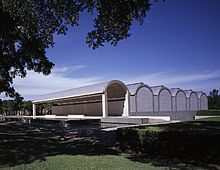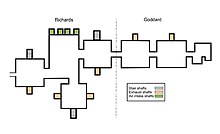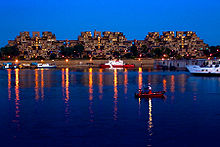
Back عمارة بنيوية Arabic Strukturalismus (Architektur) German Estructuralismo (arquitectura) Spanish ساختارگرایی (معماری) Persian Strutturalismo (architettura) Italian Структурализм Kirghiz Structuralisme (architectuur) Dutch Estruturalismo (arquitetura) Portuguese Структурализм (архитектура) Russian Štrukturalizmus (architektúra) Slovak






Structuralism is a movement in architecture and urban planning that evolved around the middle of the 20th century. It was a reaction to Rationalism's (CIAM-Functionalism)[1] perceived lifeless expression of urban planning that ignored the identity of the inhabitants and urban forms.
Structuralism in a general sense is a mode of thought of the 20th century, which originated in linguistics. Other disciplines like anthropology, psychology, economy, philosophy and also art took on structuralist ideas and developed them further. An important role in the development of structuralism played Russian Formalism,[2] also the School of Prague. Roland Barthes, a key figure of structuralist thought, argued that there was no complete structuralist philosophy but only a structuralist method.[3]
Dutch architects of structuralism did studies in a similar way as Claude Lévi-Strauss (anthropology) and were interested in the principle "langue et parole" by Ferdinand de Saussure (linguistics), especially for the theme participation.[4]
At the beginning of the general article Structuralism, the following explanations are noted:
Structuralism is a theoretical paradigm emphasizing that elements of culture must be understood in terms of their relationship to a larger, overarching system or structure.
– Alternately, as summarized by philosopher Simon Blackburn:
Structuralism is the belief that phenomena of human life are not intelligible except through their interrelations. These relations constitute a structure, and behind local variations in the surface phenomena there are constant laws of abstract culture.
- ^ Aldo van Eyck, "Statement Against Rationalism", written for CIAM VI in 1947. In: Aldo van Eyck - Writings, Amsterdam 2008. Statement against CIAM-formulations like: "Urban planning can never be determined by aesthetic considerations but exclusively by functional conclusions." This formulation came from architects of the Rationalist movement, written for the CIAM-declaration in 1928.
- ^ Todorov (Ed.), Tzvetan (1965). Théorie de la littérature. Textes des Formalistes russes. Editions du Seuil. ISBN 9 782020019293.
- ^ Barthes, Roland (1964). L’activité structuraliste. In: Essais critiques. Points (first edition Editions du Seuil). ISBN 202005809-X.
- ^ Francis Strauven, Aldo van Eyck - The Shape of Relativity, Amsterdam 1998 (1994). Biography of Aldo van Eyck and his "Configurative Discipline" of designing.
© MMXXIII Rich X Search. We shall prevail. All rights reserved. Rich X Search